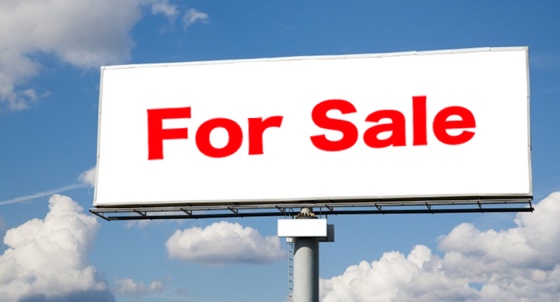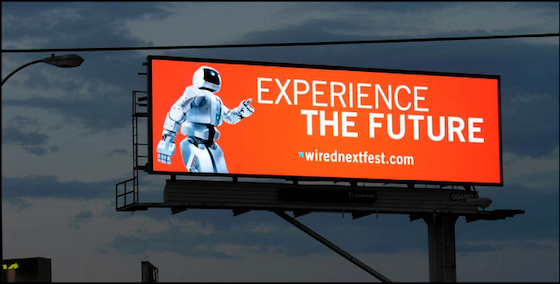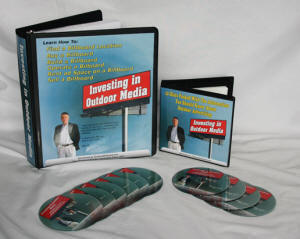Memo From Frank
The New Year is a time of redemption and goal setting. It’s a fresh slate ready for making significant progress. It’s the moment that goals can be tracked and advancement noted. The way to harness the power of the New Year is with setting down your goals on paper, and working feverishly to attain them. Back when I got in the billboard business, I built a simple way of tracking my goals. I bought a small erasable board and I put the following columns on it: “Location”, “Lease”, “Permit”, and “Built”. I then also put 20 lines on it to fill in. The goal was to fill up that board with up to 20 sign locations, and then follow along until I had the ground lease, permit and the sign built. I hung it on the wall and I stared at it every day. It was a permanent scoreboard of how I was doing, and a constant reminder of my successes and failures. I used that little board for nearly two decades. It’s one thing to make a goal, and another to proudly post your results for all the world to see. Let’s just say it’s a great motivator. If you don’t have any goals yet set for 2016, then time to do it today. Once you get those goals, set in motion knocking them off, one by one. That’s the exciting thing about the New Year – the ability to set in motion the rest of your life.
And I would like to take this opportunity to wish everyone a Happy New Year! Here’s hoping that 2016 is the best year ever!
Financial Advisors Warn That You Need At Least $1 Million In Savings To Retire: Here’s An Alternative Plan
Has America lost its mind? A recent article in the Dallas Morning News announced that retirees need at least $1 million in savings to have a decent standard of living. Seriously? Only 10% or so of Americans have a net worth of $1 million – so what’s the other 90% supposed to do? And does anyone realize how hard it is to save up $1 million to begin with? Unless you’ve already saved that much, or have a reasonable plan to do so, we’d like to present an alternative concept that’s much more reasonable: billboards.
Low-cost but high yielding sign structures
When most people think about billboards, they think about giant steel monopoles. Those are great, but they are hugely capital intensive and low yielding. A 14’ x 48’ monopole might cost you $50,000 to $80,000 in today’s market, and only has a return threshold of 10% or so. If you are trying to build a retirement income on a low price tag, you should focus on inexpensive wooden telephone pole signs, abandoned signs, 8-sheets and wallscapes. These type of signs cost between $1,000 and $5,000, and have yields as high as 100% per year. A standard wooden telephone pole sign should cost around $4,000 to build and should earn $2,000 per year or so – that’s a 50% return on investment.
Critical mass needed
Assuming a profit of $2,000, then 10 signs would make you $20,000 per year. So your goal as far as how many signs you need is based on how much you need for retirement. If you need $50,000 per year to pay all your bills and keep your quality of life, then you need to acquire 25 signs. It’s a simple process and a simple goal.
Speed to attain this amount of units
Most people are able to acquire one billboard per month, given enough effort and working smart. So if you needed 25 billboards, it would take you roughly two years to hit your goal. That’s certainly a lot less time than you need to save up a million dollars. Even if you can only work at ½ normal speed, due to other obligations, you might still be able to build the necessary income stream in 4 to 5 years. That’s still really, really fast compared to other financial options.
End result
There are certain advantages to owning billboards even besides just raw dollars and cents. It can create a great environment for retirement, with plenty of mental challenges and activity, and the ability to have social interaction with customers. You get the benefits of being your own boss, choosing your own hours, and getting 100% of the satisfaction and rewards from your success. And it also gives you much more than a retirement income; it gives you something of significant value that you can pass down as an inheritance.
Conclusion
The U.S. government and the financial community must have gone insane. They think that the average American needs to compile a mere $1 million to handle retirement. We think that a better plan is simply to build billboards and work part-time through your retirement years. Don’t listen to the so-called financial professionals, take your own route to success and take control over your financial future.
How To Sell A Billboard For Maximum Price

Very few people know about billboards, and even fewer know the correct way to sell a billboard sign. Unlike most assets, the correct procedure is nothing like you think. And the difference between doing it properly and doing it incorrectly can equate to thousands of dollars in your pocket.
Don’t set a price
The first rule of selling a billboard is to never set a price. Who ever heard of selling something without having an asking price? That’s why most people go wrong. The truth is that the value of a billboard is a function of how much it rents for, and most billboard companies rent the same sign for different amounts of money. Since you can’t predict what a big national or regional billboard company can rent your sign for, it’s important not to name a price. So you lay out all the pertinent information, such as location, ground lease specifics, photo, but absolutely no price. That’s for them to come up with.
Create an atmosphere of competition
Send the information that your billboard is for sale to every billboard company in your market. This strategy is all about volume – don’t exclude any potential buyer. You can’t possibly predict who’s trying to grow their holdings, so treat every billboard company the same and send the information to every single one.
Let the market set the price
As the potential buyers call you to ask about the price, turn the tables on them and say “I don’t really have one, I’m just looking for the best deal. What would you pay?” Typically, you’ll end up with a bunch of offers. Some will be way low. But others will be much closer to what you wanted, or even more than you expected. The key is to let the market set the price for your sign – not you.
Then do one final round of bidding
Once you get in all the offers, take the top three and play them off against each other. Call each one and say “I’ve got one offer higher than yours, and wanted to see if you wanted to raise it a little?” If they say “how much” then just make something up if they are currently in the first position. This is all a game of bluffing, just like most negotiations. They will typically assume that you really do have higher offers, so they will normally be willing to offer more money to clinch the deal.
Conclusion
Getting top dollar for your billboard is a game of strategy. Try this plan to get the maximum amount for your sign. I’ve used it over and over, and it never fails to do the trick.
Billboard Home Study Course
![]() How to Find a Billboard Location
How to Find a Billboard Location
![]() How to Buy a Billboard
How to Buy a Billboard
![]() How to Build a Billboard
How to Build a Billboard
![]() How to Operate a Billboard
How to Operate a Billboard
![]() How to Rent Ad Space on a Billboard
How to Rent Ad Space on a Billboard
![]() How to Sell a Billboard
How to Sell a Billboard
Get Your Copy Now!
The Risks Of The LED Sector Of The Billboard Business

Many people think the future of the billboard industry are digital signs, also known as LED. These signs are very visible out there, with messages that change every few seconds. But they are also extremely expensive and filled with danger in certain cases. So what’s the truth about the LED sector?
The dangers of the product
The digital sign is far from a certainty as a winning business model. Its predecessor was the “tri-vision”; triangular sign panels that showed a new message every ten seconds or so. These were introduced in the 1980s and almost every billboard company bought a couple. The concept was that you could rent each “rotation” of the sign for as much as 100% of a static sign, with the reason being the “novelty” that would attract more viewers. It worked. But after that first year the advertisers said “it’s not novel anymore, but I’ll give you about half of what I was paying”, and after the second year “I’ll give you about a third”. So, in the end, we were renting a three sided sign for the same price as a static sign – only with three times the production cost. So everyone started taking them down and throwing them away. I question if LED is not just another type of tri-vision. Are advertisers really willing to pay as much for a few seconds on a sign as they would for the entire sign 24 hours a day? I personally doubt it, and I think the performance numbers are showing I’m right.
The wrong end of the economic trends
The second problem with LED is that it is just in the wrong place at the wrong time. The U.S. economy has been in decline since 2008. Ad dollars are more scarce and customers more demanding. This is not a good time to be in the LED business. Old-fashioned, nuts and bolts signs are doing fine – they are the lowest cost per thousand exposures of all media types. But LED signs are more like the private jet part of aviation – extremely expensive and only attractive to a select few. Personally, I prefer the Walmart and Dollar Store part of the market.
The high risk involved
You will notice one thing about LED on the front end: it’s extremely expensive. A single LED sign face can run $200,000+ and only has about a 10-year shelf life. So when you get involved in LED signs, you are getting into something that is extremely expensive and risky. If you were talking about risking $10,000 or so – which is what those tri-vision units cost – that would be one thing, but LED can literally throw you into bankruptcy.
Conclusion
LED may work just fine for Clear Chanel on a sign going into downtown Chicago. They can afford to take the gamble. But for most smaller operators, LED might literally wipe you out. And the risk/reward just does not seem to be there for me. It think the jury is still out on the success or failure of LED, and I would not want to be a pioneer in that arena.
The Best Sales Advice I Ever Got
Like most people, I naturally hated trying to sell something. So I had an epiphany one day when I went on to a used car sales lot to look at a convertible that caught my eye. I was about 22 years old. I looked at the car, and the salesman said to me what has become my favorite sales pitch: “what would it take to get you to buy this car?” Prior to that, the standard sales line would be “can I help you?” or “are you interested in that car?” but here was a guy laying it all on the line. Not long after I had encountered this unbridled sales encounter, the Dallas economy collapsed and renting billboards become nearly impossible. So I adopted that sales pitch myself, with “what would it take to get you to rent this billboard?” If the customer said “I’d take it if you reduced the price by 20%” then I’d do it. If the customer said “I’d rent it if you gave me the first two months free” then I’d do it. The whole game plan was to get the customer talking to me and making me offers. There’s nothing tougher than the customer who says “no” but gives you no reason for the negativity. If you’re finding that in your sales calls, then try the line “what would it take to get you to rent this sign?” and see what happens. I might just give you the edge to close the sale.
New Billboards For Sale On OutdoorBillboard.com
The Market Report
Prices Are Delayed By At Least 15 Minutes
